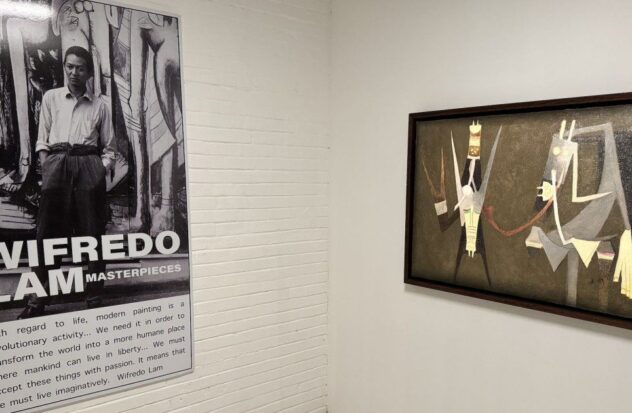Thanks to his African, Spanish and Chinese roots, in addition to his original way of approaching painting from surrealism and cubism with Afro-Caribbean touches, the artist has been the epitome of miscegenation in Cuban art. Wifredo Lam assured that surrealism allowed him to find himself and also free himself from “cultural alienations.”
On previous occasions the gallerist has presented exhibitions dedicated to the Cuban painter, such as “Wifredo Lam: A Tribute” in 1993, “Wifredo Lam Homage 100 Birthday” in 2002, “Wifredo Lam: The Imagination at Work” in 2021.
Wifredo Lam in four decades
The exhibition has 18 works that allow a journey through four decades of visual creation. This is precisely the greatest success of the exhibition, since the curation aims at an extensive tour of the painter’s creative life, with a broad look at his aesthetic path.
We see in the work of the 1940s an awakening in Lam’s style, with his experiments after coming into contact with surrealism and cubism in Europe, and combining it with his knowledge of Afro-Caribbean symbolism. The works Le Guerrier, I (The Warrior), from 1947, and “Figure (Femme Cheval)”, from 1949, stand out in the exhibition.
In the pieces of the following decade the maturity of the artist is perceived, as well as the international recognition of his work. Highlights include “doli”, from 1955, Two People and a Bird, from 1957, and “La Veille”, from 1959.
Between the 60s and 70s Lam continued to explore other ways of creating and leaned more towards the abstract, without losing his essence and powerful symbolic base. We see pieces like “Nous te voyons”, from 1964, and “Horizon Chauds”, from 1968.
The way of the teacher
Wifredo Lam (Wifredo Oscar de la Concepción Lam y Castilla) was born in Sagua La Grande on December 8, 1902, with the establishment of the Republic of Cuba, a decisive year for the island due to the proclamation of independence from Spain and the United States.
His mother, Ana Serafina Castilla, was a mulatto from Sancti Spritus, a mixture of Spanish and African; and her father, Enrique Lam-Yam, was a Chinese from Canton. The artist’s name at birth was Wilfredo, with an L, but in the 1920s, after an administrative error, his name was changed to Wifredo, something that seemed peculiar to him and that he assumed since then.
One event remained engraved in his memory: on a night in 1907, Lam experienced a deep impression when observing the shadow created by the flapping wings of a bat on the walls of his room.
It is worth noting that his godmother, Antonica Wilson, practiced Santeria and brought him closer to the symbolic world of the Yoruba pantheon and Afro-Cuban cults. Wilson gave him the protection of Shang, the owner of thunder, and Yemay, the goddess of the sea.
In 1916, Lam and part of his family moved to Havana, where he enrolled in the Professional School of Painting and Sculpture, known as the Academy of San Alejandro, until 1923, with teachers of the stature of Leopoldo Romaach and Armando G. Menocal. During this period, characterized by his participation in exhibitions at the Salon de Bellas Artes, he consolidated his vocation as a painter.
His artistic career had a transcendental transformation during his stay in Paris, where he immersed himself in the surrealist movement. During this period, he established links with prominent figures such as Pablo Picasso, André Breton and Aim Csaire, whose influence left an indelible mark on his work.
Under the tutelage of Picasso, Lam explored his fascination with African art and primitive masks. Likewise, she adopted the Spanish artist’s use of fragmented forms and abstract figures, thus consolidating a mentoring relationship that would shape her style.
This change marked the beginning of a more avant-garde stage for Lam, characterized by the fusion of cubist and surrealist techniques in his art. Additionally, she visited Mexico, where she shared with artists such as Frida Kahlo and Diego Rivera.
With the Second World War, before the arrival of the German forces, Wifredo Lam left Paris and returned to Cuba, where he remained between 1941 and 1947. On the island Lam deepened his research, and connected it with the experiences of his childhood. and youth. His sister Elosa, with whom he maintains a close relationship, brings him closer to Afro-Cuban rituals. In addition, he meets the anthropologist Lydia Cabrera and attends drumbeats and ceremonial dances with the writer Alejo Carpentier, pioneer of the marvelous real.
By consolidating his style with the influence of Afro-Cuban culture, Lam produced more than one hundred works, among which “The Jungle” (1943) stands out. His exhibitions in the United States during the following years, in places such as the Institute of Modern Art in Boston, the MoMA in New York and the Pierre Matisse Gallery, where “The Jungle” is exhibited for the first time, generated a great impact. and controversy.
Beginning in 1948, Lam traveled extensively, settling in Italy in 1960 and marrying the Swedish painter Lou Laurin. Her artistic legacy was widely recognized, receiving the Guggenheim International Award in 1964 and multiple retrospectives in prestigious European museums. Her works, which achieve record prices at international auctions, are found in collections around the world.
Wifredo Lam died in Paris on September 11, 1982.
Ms about Gary Nader
Gary Nader is recognized as one of the most successful gallery owners in the United States and Latin America. His career in the art world began in 1981 as Director of the Nader Gallery in Santo Domingo, before establishing his own Gary Nader Art Center in Miami in 1985.
Known for its focus on Latin American Art, it is recognized as the largest gallery in the world at 55,000 square feet.
In the Wynwood Art District in Miami, the center hosts a range of solo and group exhibitions, showcasing works by esteemed artists such as Abu Naba’a, Atchugarry, Basquiat, Bermdez, Botero, Bravo, Crdenas, Carreo, Chagall, Chamberlain, Chia, Condo, Cruz-Diez, De Stabler, Dubuffet, Fontana, Galn, Goldfarb, Goldin, Gursky, Henry, Hirst, Hudson, Indiana, Iturria, Kahlo, Kippenberger, Kuitca, Lam, Larraz, Lichtenstein, Manet, Martínez Celaya, Matta, Matisse, Mir, Monet, Nara, Neshat, Oehlen, Oppenheim, Pettoruti, Picasso, Rauschenberg, Rosenquist, Rivera, Ruff, Scheibitz, Soto, Stella, Tamayo, Toledo, Torres-Garca, Vari, Vasarely, Venet, Warhol and Zuiga.
With more than 2,000 pieces from the 20th and 21st centuries, the Gary Nader Private Collection showcases the richness of modern and contemporary art.
Ms informacin: Gary Nader Art Centre, 62 NE 27th St, Miami, FL 33137. (305)576-0256 garynader.com




